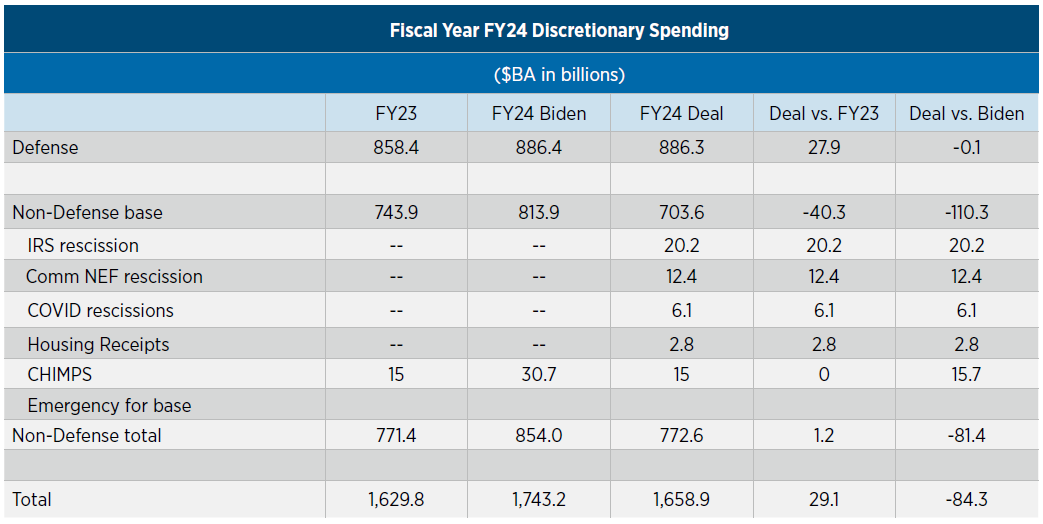January 22, 2024
Politics Over Governing?


The last time that Congress passed and the President signed all of the individual appropriations bills by October 1, the first day of the fiscal year, was FY95. An entire generation of Senators and Representatives has never participated in an appropriations process that met the deadlines established in the Congressional Budget Act of 1974. Since then, Congress has enacted over 140 continuing resolutions (CRs) in order to fund the government while awaiting negotiation of the final bills, mostly as a result of divided government.
The first session of the 118th Congress was perhaps the least productive Congress in over seventy years. Only 34 laws were enacted, compared to an average of over 200 laws enacted each first session of Congress over the last seventy years. Agencies continue to wait for the most fundamental guidance from Congress— how to allocate taxpayer dollars.
House Republican Leadership directed FY24 bills be marked up at around $119 billion less than the non-defense topline established in the Fiscal Responsibility Act (FRA) signed last June. The Senate marked up bills that aligned with the caps but added extra money. These differences made it necessary for House and Senate leadership to negotiate on toplines. House Speaker Johnson (R-LA) and Senate Majority Leader Schumer (D-NY) announced a $1.66 trillion topline agreement on January 7.
Before we even talk about Ukraine, I’m going to tell the President…border, border, border. We have to take care of our own house. We have to secure our own border before we talk about anything else.
Speaker Johnson (R-LA),
January 17
The topline agreement leaves fundamental issues unresolved, including:
- So-called poison pill riders, including abortion restrictions, family planning, climate change and environmental limits, diversity, and racial justice, campaign finance, and other issues that have been subject to veto threats from the Biden Administration;
- Whether FY24 supplemental funding issues will become tied to negotiations on the FY24 appropriations Supplemental appropriations for border security (and immigration law changes), Ukraine funding, aid to Israel, and humanitarian assistance for the Palestinians, Child Care assistance, and funding for the Women Infants and Children shortfall are all under consideration.
- Resolving significant House-Senate differences on FY24 funding for education, housing, nutrition, foreign assistance, infrastructure, and science, research and For example, the House provides $44.8 billion for the National Institutes of Health, the Senate $49.2 billion. The House provides Department of Energy Science and ARPA Energy $8.1 billion, the Senate $8.4 billion.
How quickly resolution of such issues is achieved, will be partly a function of whether politics prevails over governing. To avoid an early March shutdown, the Speaker must decide whether to pass the FY24 bills, as well as the security supplemental, on a bipartisan basis or with his narrow majority.
Overall, this agreement represents an actual year-over-year cut in non-VA, nondefense spending. The agreement also represents an overall cut of tens of billions below the levels in the current CR.
Speaker Johnson (R-LA),
January 7
THE TOPLINE AGREEMENT
Topline levels essentially match those set in the FRA for both defense ($886.3 billion) and non-defense ($772.7 billion). (Chart I)
- The agreement would reduce spending below the levels in the bipartisan Senate Appropriations Committee bills by $8 billion in defense and $7 billion in non-defense spending.
- Defense is $27.9 billion above FY23 and non-defense spending is essentially a freeze at FY23 Compliance with that non-defense freeze level, will require about $16 billion in non-defense cuts to offset the increased costs of the FY24 advance appropriation already enacted for VA Medical Care, for reduced housing receipts, and for the costs of maintaining existing assisted housing renewal levels.
- The agreement sets non-defense funding at a level $81 billion below President Biden’s FY24 Budget request and sets defense funding at the request level.
The bipartisan funding framework congressional leaders have reached moves us one step closer to preventing a needless government shutdown and protecting important national priorities.
President Biden,
January 7
STATUS OF CONTINUING RESOLUTION
Since October 1, 2023, agencies have been operating under a series of Continuing Resolutions (CRs) at levels and terms and conditions established for FY23, enacted over one year ago.
- The second CR funds four of the twelve appropriations bills (Agriculture, Energy-Water, Transportation-Housing and Urban Development, and Military Construction- Veterans Affairs) through January 19.
- The same CR funds eight of the twelve appropriations bills (Commerce-Justice-Science, Defense, Financial Services-General Government, Homeland Security, Interior, Labor-Health and Human Services-Education, Legislative Branch, and State- Foreign Operations) through February 2.
- On January 19, the President signed the third CR extending funding for the four January 19 bills through March 1 and for the eight remaining bills through March 8. The extension passed the Senate 77-18 and the House 314-108.
In the absence of enactment of full year bills or extension of the CR, a shutdown for the agencies funded by the first four bills would commence on March 2 and the remaining eight bills on March 9.
Depending on the duration, a shutdown can reduce federal revenues, hurt GDP and have significant impact on services critical to American families and the economy. For example, if the Transportation bill is not enacted or extended, for example, the Federal Aviation Administration will furlough over 17,000 employees and 26,000 air traffic controllers and aircraft security personnel would be working without pay. If the Homeland Security bill is not enacted or extended by February 2, Border Patrol and Customs officers would be working without pay.


Chart I. Source: Jan. 7 Dear Colleague Letter from Speaker Johnson, FBIQ analysis. Notes: IRS – Internal Revenue Service; Comm NEF – Commerce Nonrecurring Expenses Fund; CHIMPS – Changes in Mandatory Programs
RISKS AND OPPORTUNITIES
Until Congress finishes its work on FY24 spending bills, agencies can’t launch new programs, often have money in the wrong places, and face planning challenges due to uncertain funding levels. Once final FY24 bills are passed, many agencies will be faced with a combination of flat budgets, inflation in costs of goods and services, and a 5.2% federal pay hike (beginning in January 2024), forcing tough choices. Options could include hiring freezes and employee furloughs. In this environment, expect program and contract award/start date delays for most agencies. Such scenarios could create cash flow headaches for industry, but also a potential opportunity for federal contractors to provide temporary staffing augmentation and a competitive edge over the government in the war for talent.
LOOKING AHEAD TO FY25 – AUSTERITY CONTINUES
The FRA also contains topline limits for FY25, including increases of only one percent for defense and non-defense. However, the FY24 topline agreement uses over $10 billion of the IRS rescission that was assumed to be enacted in FY25 and the agreement exhausts most unspent COVID balances.